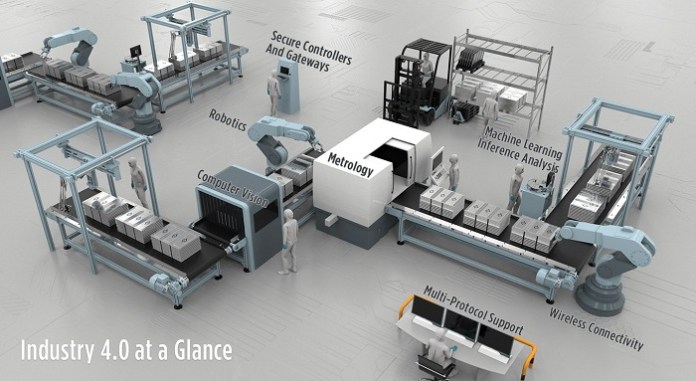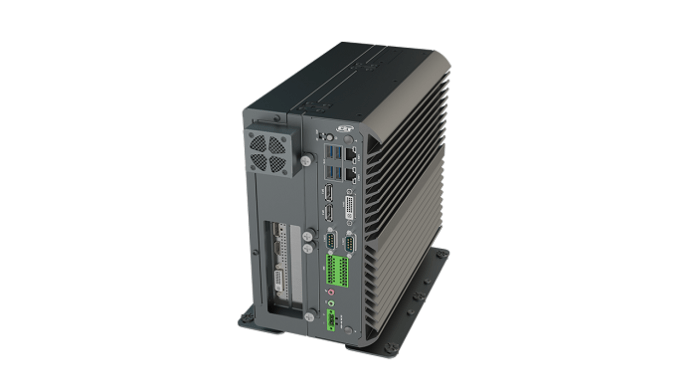In manufacturing, the industrywide effort to tap into data generated by both legacy and modernized systems is probably one of the best and most accurate definitions of digital transformation. Improvements are motivated by intelligent automation – or rather its byproduct, efficiency. On this landscape, emerging data-driven applications like advanced robotics and machine learning are becoming familiar strategic objectives, fueling safer and more competitive operations such as precision object detection or automated inspection.
Processing complex visual tasks more efficiently than the human eye requires data in real time and lots of it. Specialized computer hardware like industrial GPU computing solutions must be powerful enough to run complex vision algorithms and consolidate workloads that resemble data center computing. For system developers, this unique set of performance requirements underscores the engineering roadblocks common to the rugged edge: how to facilitate artificial intelligence (AI) and machine learning in heavy industrial environments that are environmentally rigorous, uncontrolled, or subject to instability.
Deployed systems must be both high performance and high reliability by design. Downtime is costly and can also cause expensive delays and safety issues on the manufacturing line.
AI-powered metrology
Inspection automation is a precision aspect of manufacturing that demonstrates the value of real-time data on the factory floor. Metrology, the quality control operations used to measure and inspect manufactured components, can be perfected with more sophisticated vision technology. Fully automated in-line systems can evaluate every component and significantly increase throughput, in contrast to legacy inspection platforms where only a small percentage of manufactured product is sampled from a batch. In-line or near-line metrology systems offer far greater control in reducing defective products from going into market.
More advanced, AI-powered metrology can be illustrated by the operations of a leading provider of precision metrology solutions for global manufacturers. The company matched its multi-sensor array with a purpose-built industrial GPU computer. The resulting system powers its flagship solution, a new non-contact metrology platform that inspects manufactured components up to 10 times faster than traditional measuring machines. This next-generation system represents a marked difference from legacy metrology capabilities and enables manufacturers to increase overall quality, efficiency, and throughput.
More about metrology
Industrial metrology applies to a wide field of applications for calibration, testing, and measurement. The process relates to nearly any type of part coming down the manufacturing line, certifying the quality of manufacturing products such as sub-assemblies or smaller components that are then integrated into critical systems. Because metrology deals in micro measurements of end products, industries can significantly reduce their production costs with skillful calibration and tighter process controls. In-line metrology not only improves speed and quality control results but increases efficiencies and ROI based on less waste.
Yet, many high-volume manufacturing systems sample parts rather than inspect 100 percent of the production line. The nature of parts, their complex shapes and measurements, along with an aggressive production pace, prevents a 100 percent inspection from being feasible. If a flaw is found when only samples are measured, there is a strong likelihood that a high number of defective parts have already passed through the production line. Parts cannot typically be re-rolled and would instead be scrapped by the manufacturer.

Poor calibration during manufacturing can impact corporations . Industries can significantly reduce their production costs with skillful calibration and tighter process controls. (Image: Premio)
Non-contact metrology taps into machine vision
In our example, this global provider of industrial automation and metrology solutions relies on non-contact metrology methods or machine vision-based systems – these advanced technologies enable rapid measurements and manage complex dimensions down to the micron. Products are not handled (or destroyed) in the testing process, eliminating the need for fixturing or the process of holding individual parts stiffly to avoid movement during measurement.
Instead, the platform measures intricate parts by scanning only, via an extensive range of sensors and cameras scanning as many as 500 parts per second. Probes and confocal lenses are used to help determine the nature of any defect, and the system will soon add LiDAR for additional high-speed scanning. In contrast to traditional coordinate measuring machines (CMM), the company’s automated metrology platform uniquely employs advanced vision and multi-sensor technology. Millions of data points are captured per second and complex geometries with multiple facets are analyzed down to microns, or a millionth of a meter.
The company uses Premio’s VCO-6020-1050Ti GPU-based industrial computer with machine vision capabilities as the compute engine for its system. Multiple measurements are delivered simultaneously, handled by a powerful GPU that analyzes and processes all data points and compiles results in real time. Working in conjunction with the system’s industrial GPU, the metrology firm’s proprietary software stitches together the data points to synthesize the data in a single location.

Premio’s rugged edge solution integrates NVIDIA’s GeForce GTX 1050 Ti for efficient parallel processing of vision and sensor workloads. The GTX 1050 Ti features NVIDIA’s Pascal architecture, including 768 CUDA Cores and 4 GB GDDR5 memory to enable the high precision measurements critical for quality control operations on the manufacturing line. Accelerated processing includes fast handling of graphical images, measuring surface finishes such as color, gloss, and texture at microscopic levels. (Image: Premio)
Adding value through automation
Metrology is a critical process for any product coming off a manufacturing line; however, some products have even less room for error than others. Medical devices, for example, those that are implanted in the human body, are regulated by a 100 percent inspection requirement.
AI-powered metrology has also enabled manufacturers of consumer electronics with a 100 percent inspection option. Ideal for costly consumer devices; the process has also increased their ability to inspect and measure elements that were previously unable to be measured. As many as 400-500 critical dimensions can now be measured in a few seconds, unheard of through traditional metrology operations.
Connecting everything
The science of measurement plays a critical role in the manufacture of products – from consumer electronics to implantable heart valves. With more advanced and automated capabilities, industrial leaders can solve complex and longstanding measurement requirements for a greater number of critical devices.
The more devices become connected the more valuable the data. Legacy systems commonly coexist with newer devices that have the ability to record and process data, driving a need to update manufacturing infrastructures. This is where AI-powered metrology enters – at the intersection of high-performance compute systems, advanced vision and lighting technologies, and IoT connectivity, coming to the forefront of manufacturing environments.
Data is collected, analyzed, and delivered back into the manufacturing system in real time, seamlessly driving more intelligent decision-making in heavy industrial production environments. It is an infrastructure shift that redefines the factory floor, tapping into deeper levels of data and making it actionable for long-term competitive value.
About the author
As Premio Inc.’s director of product marketing, Dustin Seetoo crafts technical product marketing initiatives for industries focused on the hardware engineering, manufacturing, and deployment of industrial internet of things (IIoT) devices, and x86 embedded and edge computing solutions. Connect with Dustin via LinkedIn or dustin.seetoo@premioinc.com.
Advertisement
Learn more about Premio





